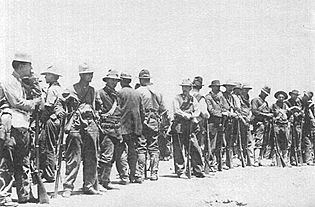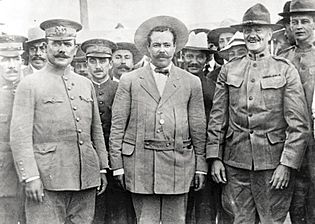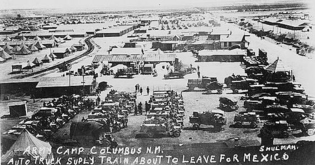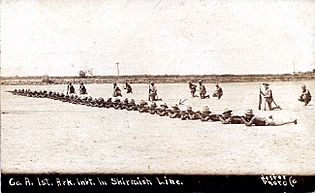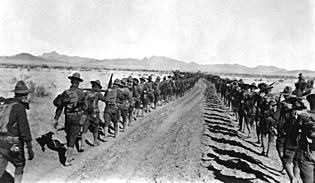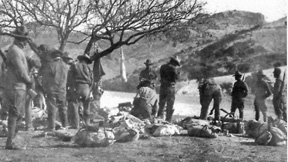Mexican Border War (1910–1919) facts for kids
Quick facts for kids Border War |
|||||||
|---|---|---|---|---|---|---|---|
| Part of the Mexican Revolution, Banana Wars and World War I | |||||||
 |
|||||||
|
|||||||
| Belligerents | |||||||
|
|||||||
| Commanders and leaders | |||||||
| Álvaro Obregón Venustiano Carranza Pancho Villa Felipe Ángeles Aniceto Pizana Luis de la Rosca |
Herbert J. Slocum John J. Pershing Frank Tompkins Frederick J. Herman |
||||||
| Casualties and losses | |||||||
| 867 soldiers, militia, and insurgents killed 400+ civilians killed |
123 soldiers killed 427 civilians killed |
||||||
The Mexican Border War, also called the Border Campaign, was a series of military fights. These battles happened along the Mexico–United States border in North America. They took place during the Mexican Revolution, a big civil war in Mexico.
This war also happened during World War I. At that time, Germany tried to get Mexico to attack the United States. Germany even fought against American forces in Mexico. The Border War was one of the last major conflicts fought on American soil. It followed earlier wars like the American Revolutionary War and the American Civil War.
The fighting began in 1910 when the Mexican Revolution started. The United States Army was sent to the border to protect American citizens and property. They often fought with Mexican rebel groups or government soldiers. The most intense part of the conflict was in 1916. The Mexican revolutionary leader Pancho Villa attacked the American town of Columbus, New Mexico.
In response, the United States Army, led by General John J. Pershing, went into northern Mexico. Their goal was to find and capture Pancho Villa. Even though Villa was not caught, the US Army fought his rebels and killed two of his main commanders. Villa escaped, and the American army returned to the United States in January 1917.
However, fighting continued along the border. The United States launched more, smaller operations into Mexico. After the American victory in the Battle of Ambos Nogales in August 1918, a permanent border wall was built there. The conflict involved not only Villa's forces and Americans, but also other Mexican groups and even Germans.
Key Events of the Border War
1910: Revolution Begins
- Revolutionary fighting started in Mexico.
- The United States Army sent soldiers to border towns. They wanted to protect Americans and keep the fighting in Mexico.
- Francisco I. Madero, a Mexican leader, called for Mexicans to rise up against their government. He did this from San Antonio, Texas.
- Madero planned to attack a border town but canceled it due to lack of support.
1911: Early Conflicts
- Mexican rebels called Magonistas captured Mexicali and Tijuana in Baja California.
- The Mexican government fought back, forcing the rebels to surrender to the US Army.
- Francisco Madero's rebels fought federal troops at Agua Prieta, Sonora. US troops in Douglas, Arizona, were attacked and fired back, helping Madero's rebels take control.
- Madero's rebels, including Pancho Villa, fought a major battle at Ciudad Juárez. US soldiers in El Paso, Texas, exchanged fire with rebels, causing minor injuries.
- After much fighting, Porfirio Díaz was exiled, and Francisco Madero became President of Mexico. He tried to end the fighting.
1912: New Rebellions
- The United States Army continued to guard American border towns.
- General Pascual Orozco rebelled against President Madero in Chihuahua. Madero's army defeated Orozco.
- Pancho Villa also rebelled against Madero's government soon after.
- Mexican federal forces built Fort Tijuana to protect the border with California.
1913: Border Forts and Meetings
- General Obregón's army attacked Nogales, Sonora. The Mexican defenders surrendered to the US Army in Nogales, Arizona.
- The Battle of Naco was fought across the border from Naco, Arizona. US troops watched the battle.
- American troops in Naco, Arizona, began building Fort Naco. This was one of 12 forts built by the US Army to protect against Mexican forces.
- General John Pershing and Pancho Villa met at Fort Bliss, Texas. They met again in 1914.
1914: US Intervention in Mexico
- The Tampico Affair happened when US Navy sailors were arrested in Tampico, Mexico. This led to the US and Mexico ending diplomatic relations.
- President Woodrow Wilson asked Congress to approve an invasion of Mexico.
- The US Navy occupied the city of Veracruz after a fight with Mexican defenders.
- The longest battle of the Mexican Revolution was fought at Naco, Sonora. Pancho Villa's men attacked General Obregón's forces for 119 days.
- During the Naco battle, US Buffalo Soldiers in Naco, Arizona, were wounded by rebel gunfire. They did not fire back and were praised for their discipline.
1915: Raids and Shifting Alliances
- A plan called the "Plan de San Diego" was discovered. It was a plot to start a conflict in Texas, New Mexico, Arizona, and California. Some raids into Texas did occur.
- Pancho Villa attacked General Obregón's forces at Nogales, Sonora. US soldiers in Nogales, Arizona, were also attacked and fought back.
- Villa's forces fought again at Agua Prieta. Villa blamed his defeat on large searchlights used by the US Army.
- Villa's forces suffered another defeat at the Battle of Hermosillo.
1916: Pancho Villa's Attack and US Expedition
- In January, Villistas stopped a train and killed eighteen American passengers near Santa Isabel, Chihuahua.
- On March 9, Pancho Villa's forces raided Columbus, New Mexico, for supplies. Villa's men were defeated by US soldiers. Columbus was badly damaged.
- In response, President Wilson ordered General John J. Pershing to lead over 5,000 men into Mexico. This was the Pancho Villa Expedition, meant to capture or kill Villa.
- On May 5, Villa's rebels attacked two more American border towns in Texas: Glenn Springs, Texas, and Boquillas, Texas. US soldiers were killed or wounded.
- American forces rescued two captives taken by the raiders during a small cavalry expedition into Mexico.
- President Wilson ordered the National Guard to reinforce US Army bases along the border. By August, about 117,000 guardsmen were stationed there.
- On April 12, American forces fought Carrancistas at the Battle of Parral in Chihuahua. This was the furthest American forces went into Mexico.
- In June, US Buffalo Soldiers suffered a defeat at the Battle of Carrizal against Mexican federal troops.
- Raids on American border towns continued.
- Future General George S. Patton led America's first attack using armored vehicles. Three Mexicans were killed, including a Villista general.
1917: US Withdrawal and German Plot
- President Wilson ordered General Pershing to leave Mexico and end the expedition. Most US troops were back at the border by January.
- The Zimmermann Telegram was discovered by the British. In this secret message, Germany asked Mexico to join World War I on Germany's side if the US declared war. Germany promised to help Mexico get back land lost to the US.
1918: Last Major Battles
- US Army Intelligence found German military presence in Sonora, Mexico. They prepared for possible war with Mexico.
- Revolutionary Yaqui Native Americans had a weapons base in Bear Valley, Arizona. US troops attacked them, destroying the camp and capturing rebels.
- In August, a major battle called the Battle of Ambos Nogales occurred. A dispute at the border in Nogales quickly grew into a large fight.
- US soldiers and cavalry attacked Mexican positions on hills. The Mexican troops and their German advisers were defeated. Many Mexicans and two Germans died, along with seven Americans.
- After this battle, German military activity in Sonora stopped. The Battle of Ambos Nogales was the last major fight of the Border War.
1919: End of the Conflict
- American and Mexican forces fought near El Paso, Texas, in the Battle of Ciudad Juárez.
- This battle was unique because the Mexican army and the American army joined forces. They fought together against the Villistas led by Pancho Villa.
- This was the second-largest battle involving the US in the Mexican Revolution. It is considered the last battle of the Border War.
Images for kids
See also
 In Spanish: Guerra fronteriza para niños
In Spanish: Guerra fronteriza para niños



